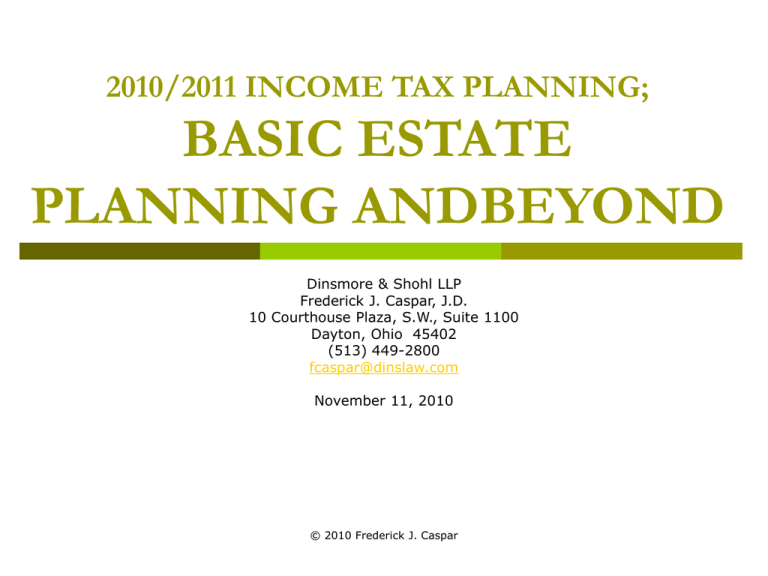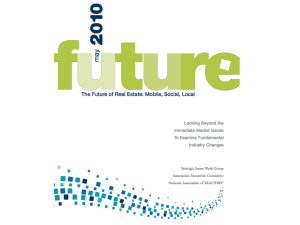BASIC ESTATE PLANNING AND BEYOND
advertisement

2010/2011 INCOME TAX PLANNING; BASIC ESTATE PLANNING ANDBEYOND Dinsmore & Shohl LLP Frederick J. Caspar, J.D. 10 Courthouse Plaza, S.W., Suite 1100 Dayton, Ohio 45402 (513) 449-2800 fcaspar@dinslaw.com November 11, 2010 © 2010 Frederick J. Caspar BRIEF SUMMARY OF UPCOMING CHANGES 2 ROTH IRA CONVERSIONS Roth Conversion (previously 100,000 AGI limit) • Pay taxes in 2010, or • Spread income equally in 2011 and 2012 ○ Election not due until 2010 tax return filed. 3 SMALL BUSINESS JOBS AND CREDIT ACT (9/2010) • Section 179 Deduction for Equipment ○ Limit increased from $250,000 to $500,000 in 2010 and 2011. ○ Phase-out starts at $2 Million of qualified property vs. $800,000 previously. 50% Bonus Depreciation Extended to 2010 Self-employed taxpayers able to deduct health insurance premiums from earned income in 2010. 4 HEALTH REFORM ACT (3/2010) In 2010 forward, sliding scale tax credit for qualified small employers to offset employer health insurance cost. • In 2013 forward: • • See calculation at www.NFIB.com/creditcalculator Additional tax of 0.9% on earned income over $200,000/$250,000 for single/joint taxpayers. Additional tax of 3.8% on unearned income to the extent modified AGI exceeds $200,000/$250,000. In 2018 forward: 40% excise tax on health insurance premiums in excess of $10,800/$27,500 for individual/family coverage 5 INCOME TAX CHANGES 2010 Joint Tax Rates $0 to $16,750 16,750 to 68,000 68,000 to 137,300 137,300 to 209,250 209,250 to 373,650 Over 373,650 10% of amount over $0 $1,675.00 + 15% of amount over $16,750 $9,362.50 + 25% of amount over 68,000 $26,687.50 + 28% of amount over $137,300 $46,833.50 + 33% of amount over 209,250 $101,085.50 + 35% of amount over 373,650 6 Expected 2011 Tax Rates If taxable income Is over $0 $60,699 $146,660 $223,485 $399,144 But not over $60,699 $146,660 $223,485 $399,144 unlimited The tax is: 15% of the amount over $0 $9,104.80 plus 28% of the amount over $60,699 $33,173.86 plus 31% of the amount over $146,660 $56,989.60 plus 36% of the amount over $223,485 $120,226.94 plus 39.6% of the amount over $399,144 7 Simple Example Married couple has the $100k AGI, 4 exemptions & no deductions. What is their tax for each year? 2010 2011 Taxable Income $74,000 $75,200 Tax $10,863 $13,451 Effective Average Tax Rate Marginal Bracket 10.86% 13.45% 25% 28% 8 Example with Unearned Income Married couple has the $400k AGI, $300k dividend, $100k ordinary income, 4 exemptions & no deductions. What is their tax for each year? 2010 2011 Taxable Income $374,000 $390,200 Tax $ 55,863 $118,043 Effective Average Tax Rate Marginal Bracket 13.97% 29.5% 35% 40% 9 To Net $1After Federal Income Taxes Capital Gains Max. Rate Gross Increase 2010 15.0% $ 1.18 2011-2012 20.0% $ 1.25 6% 2013 & later (HI tax) 23.8% $ 1.31 11% Dividends Max. Rate Gross Increase 2010 15.0% $ 1.18 2011-2012 39.6% $ 1.66 40% 2013 & later (HI tax) 43.4% $ 1.77 50% 10 Some 2010 Year-End Planning 11 Will 2010 Rates be Extended If not • Roth conversion in 2010. • Trigger capital gains/buy back stocks if desired. ○ If capital loss carry-forwards would offset, no benefit. • Avoid taking capital losses until 2011. • Sell property on installment basis. ○ Have until as late as 10/15/11 to decide whether to report in 2010 or 2011. • Should expenditures be capitalized and not expended. ○ Sections 59(e), 174, 263, 266 • Consider avoiding tax free exchanges/rollovers. • Pay bonuses after March 15, 2011. ○ Employees may want to accelerate bonuses. • Avoid bonus depreciation/use slower depreciation. • Accelerate 15% C corporation dividends into 2010. 12 BASIC ESTATE PLANNING AND BEYOND 13 ESTATE TAX RATE CHANGES Year Estate Tax Exemption 2009 $3,500,000 2010 Estate tax repealed 2011 and beyond $1,000,000 Top Estate Tax 45% 0% 55% 14 Federal Estate Tax Rate Schedule for 2011 and Beyond. Taxable amount over Taxable amount not over Marginal tax rate (percent) 1,000,000 1,250,000 41 1,250,000 1,500,000 43 1,500,000 2,000,000 45 2,000,000 2,500,000 49 2,500,000 3,000,000 53 3,000,000 -- 55 10,000,000 17,184,000 60 15 GIFT TAX CHANGES • 35% tax rate in 2010. • 41% to 60% tax rate in 2011 and beyond. 16 THE NEED FOR ESTATE PLANNING NON-FINANCIAL GOALS • Give what you want. • To whom you want. • When and in the manner in which you want. FINANCIAL GOALS • At the least possible tax cost, consistent with other goals. • With needed liquidity to allow for implementation of non-financial goals. 17 SOME RESULTS OF BAD PLANNING Allow the State to decide who is entitled to your assets, and when. Significantly and unnecessarily reduce family wealth. Jeopardize family business. Jeopardize the financial and mental health of your beneficiaries. 18 SOME NON-FINANCIAL DECISIONS GUARDIAN • For minor children • For you • Successor EXECUTOR • Role • Fees TRUSTEE • For children ○ Special needs trust • For parents, or other family members • Asset protection for beneficiaries • Business transition 19 SOME NON-FINANCIAL DECISIONS (cont.) AVOIDANCE OF PROBATE—ADVANTAGES OF FUNDING A LIVING TRUST • • WHAT A LIVING TRUST WILL NOT DO • • Probate Administration with respect to assets in trust is avoided. ○ Court fees saved ○ Court delays avoided ○ Executor and attorney fees saved ○ Especially important to avoid multiple probates if property is owned in other states Confidentiality. ○ Estate, its value, and identity of beneficiaries is not a matter of public record Save estate taxes Protect assets from creditors during life OTHER WAYS TO AVOID PROBATE • • Transfer/payable on death Beneficiary designation 20 SOME NON-FINANCIAL DECISIONS (cont.) DURABLE POWERS OF ATTORNEY • Name Attorney-in-Fact/Successor • Name Guardian of you/children HEALTH CARE POWERS/LIVING WILLS • Allows you to make your own choice • Organ Donation • DNR Orders 21 SOME NON-FINANCIAL DECISIONS (cont.) LEAVE ROADMAP • • • • Consolidate assets Consolidate papers Leave financial statement Leave advisor information 22 SOME FINANCIAL OBJECTIVES PRENUPTUAL • Family Partnership/Trusts can also maintain separate property nature of assets LONGTERM CARE/MEDICAID • Insurance • Asset planning GIFTING PROGRAMS • • • • • • Gift and estate taxes are here to stay Annual exclusion Section 529 plans Custodian accounts “Formal” trusts Can reduce income taxes MINIMIZE ESTATE TAXES 23 ESTATE TAX SCHEDULE 2011 Federal Estate Tax Rate Schedule for 2011 and Beyond Taxable amount over Taxable amount not over Marginal tax rate (percent) 1,000,000 1,250,000 41 1,250,000 1,500,000 43 1,500,000 2,000,000 45 2,000,000 2,500,000 49 2,500,000 3,000,000 53 3,000,000 -- 55 10,000,000 17,184,000 60 24 CASE STUDY ONE VALUE OF ESTATE IS NOT EXPECTED TO EXCEED EXCLUSION AMOUNT • Estate taxes not a consideration. ○ Focus on non-financial goals ○ Note Ohio estate tax (7%) on estates over $338,000 − − − Spousal exemption Life insurance designation Lifetime gifts • Confirm no “hidden” assets. ○ Death benefit of life insurance ○ Asset appreciation ○ Retirement accounts • “Joint Trust” vs. separate living trusts • Opportunities for Income Tax Planning ○ Lifetime gifts ○ Charitable gifts 25 CASE STUDY ONE (CONT.) GIFTS OF APPRECIATED STOCK OR REAL ESTATE • By avoiding capital gains tax, a $1,000 contribution made this way can cost as little as $450. Contribution Less capital gain tax avoided (20% x 1,000) Less tax savings to donor from deduction (1,000 x 35%) Net Cost to Donor $1,000 (200) (350) $ 450 CHARITABLE BEQUESTS • A charitable bequest is a gift by Will (or trust) to a charity. If the gift is so-called IRD (Income in Respect of a Decedent), such as an IRA or a 401(k) benefit, it reduces estate taxes and income taxes. An IRA or 401(k) benefit is subject to both estate and income taxes at death of up to 68 percent; naming a charity as a beneficiary avoids both of these taxes. • Note Section 691(c) income tax deduction if there is estate tax on IRD. 26 CASE STUDY TWO VALUE OF ESTATE EXCEEDS EXCLUSION AMOUNT FOR ONE SPOUSE, BUT NOT FOR BOTH SPOUSES (Assumes $1,000,000 Exclusion per spouse) Residence Investments (including retirement accounts) Family Business/Rental Real Estate Life Insurance on Mr. Brown TOTAL VALUE OF ESTATE $ 300,000 700,000 500,000 500,000 $2,000,000 27 CASE STUDY TWO (cont.) Mr. Brown’s Estate $2,000,000 Mrs. Brown’s Estate $435,000 IRS $1,565,000 John, Sue and Debbie 28 ESTATE TAX PLANNING WITH CREDIT SHELTER (“B”) TRUST Mr. Brown’s Estate $1,000,000 • $1,000,000 To Mrs. Brown's "A” Trust Distributable to Mrs. Brown without restriction • • • • To Mrs. Brown’s “B” Trust Net income to Mrs. Brown Discretion in Trustee on principal to Mrs. Brown for health, maintenance and support Up to 5% of principal each year at Mrs. Brown’s election for any reason Mrs. Brown is Trustee On Mrs. Brown’s Death $0 IRS $2,000,000 John, Sue and Debbie 29 TITLING OF ASSETS Split between spouses ○ Do not know who will pass first Adjust beneficiary/joint and survivor designations Asset protection from acts of one spouse 30 CASE STUDY THREE VALUE OF ASSETS EXCEED BOTH SPOUSES EXCLUSION AMOUNT 31 CASE STUDY THREE (cont.) Add Insurance Trust Mr. Brown’s Estate $2,000,000 Premiums Funded $1,000,000 $1,000,000 To Mrs. Brown’s “A” Trust • Distributable to Mrs. Brown without restriction. • • • • To Mrs. Brown’s “B” Trust and Insurance Trust Net Income to Mrs. Brown. Discretion in Trustee on principal to Mrs. Brown for health, maintenance and support. Up to 5% of principal each year at Mrs. Brown’s election for any reason. Mrs. Brown is Trustee. Insurance Trust $500,000 On Mrs. Brown’s Death $0 IRS $2,500,000 John, Sue & Debbie 32 CASE STUDY THREE (cont.) Add Annual Gifts Year Annual Gifts* 1 $78,000 2 $78,000 3 $78,000 4 $78,000 5 $78,000 6 $78,000 7 $78,000 8 $78,000 9 $78,000 10 $78,000 Total Value Transferred Estate Tax Rate Transfer Tax Savings through Year 10 Value in Year 10 @ 6% $ 139,680 131,780 124,320 117,280 110,640 104,380 98,470 92,900 87,640 82,680 $ $ 1,089,770 x55% 599,375 * Assumes three donees. 33 ADD NON-VOTING COMMON STOCK/FAMILY LIMITED PARTNERSHIP, LLC Mrs. Brown (or Living Trust) Voting Stock/ General Partner Mrs. Brown (or Living Trust) Non-Voting Stock/ Limited Partner Non-Voting Stock/ Limited Partner Voting Stock/ General Partner Outright or to Trusts for Children John Sue Debbie BROWN FAMILY BUSINESS OR LIMITED PARTNERSHIP Owns: • Family Business, or rental Real Estate/Investments Allows For: • Control separate from economic ownership • Asset protection • Discounted gifting 34 LEVERAGED ANNUAL GIFTS Year Annual Gift of Non-Voting Stock or Limited Partner Interests Post Discount Annual Gifts* Value in Year 10 @ 7% 1 $130,000 $78,000 $232,800 2 $130,000 $78,000 219,630 3 $130,000 $78,000 207,200 4 $130,000 $78,000 195,470 5 $130,000 $78,000 184,400 6 $130,000 $78,000 173,970 7 $130,000 $78,000 164,100 8 $130,000 $78,000 154,800 9 $130,000 $78,000 146,000 10 $130,000 $78,000 137,800 Total Value Transferred $1,816,170 Estate Tax Rate x55% Transfer Tax Savings through Year 10 $ 998,894 Additional Tax Savings as Compared to Non-Leveraged Gifts $ 399,519 * Assumes three donees; 40% discount. 35 LEVERAGED ANNUAL GIFTS (cont.) ADDITIONAL BENEFITS OF FAMILY ENTITY STRUCTURE • • • • • • • • • Asset protection To hold and manage family assets To provide centralized management To encourage children to become knowledgeable in family investment activities To provide investment diversification to donees To provide a degree of asset protection from divorce or creditor judgments for non-managing/non-voting members To provide opportunity to transfer wealth to future generations while allowing the donor to retain managerial control To provide an administratively easier way to transfer a “basket” of assets To avoid fractionalizing management and control of undividable property 36 ADDITIONAL GIFTING TECHNIQUES Grantor Retained Annuity Trusts Defective Grantor Trust Installment Sale Planning for Businesses Qualified Personal Residence Trust Charitable Lead Trust Charitable Remainder Trust Additional Leveraging with Life Insurance 37







